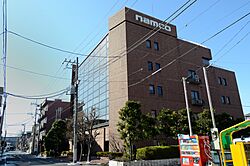Namco facts for kids
Logo (reused by Bandai Namco Amusements for its arcade chain of the same name)
|
|

Headquarters in Ōta, Tokyo
|
|
|
Native name
|
株式会社ナムコ
|
|---|---|
|
Romanized name
|
Kabushiki-gaisha Namuko |
|
Formerly
|
|
| Subsidiary | |
| Industry | Video games |
| Fate | Merged with Bandai's video game operations to form Namco Bandai Games |
| Successor | Bandai Namco Entertainment |
| Founded | June 1, 1955 |
| Founder | Masaya Nakamura |
| Defunct | March 31, 2006 |
| Headquarters |
,
Japan
|
|
Area served
|
Worldwide |
|
Key people
|
|
| Products | Video games |
| Parent | Namco Bandai Holdings (2005–2006) |
| Divisions |
|
| Subsidiaries |
|
Namco Limited was a Japanese company that made video games and entertainment products. It started in 1955. Namco ran video arcades and amusement parks all over the world. They also made video games, movies, toys, and arcade cabinets.
Namco was very important in the arcade game world. They created many popular game series that sold millions of copies. Some of these include Pac-Man, Galaxian, Tekken, Tales, Ridge Racer, and Ace Combat.
The name Namco comes from Nakamura Manufacturing Company. This name honors its founder, Masaya Nakamura. In the 1960s, Namco built arcade games that used electricity and mechanics. A big hit was Periscope in 1965.
Namco joined the video game industry in 1974. They bought the Japanese part of Atari. This allowed them to sell games like Breakout in Japan. The company changed its name to Namco in 1977. Their first original video game, Gee Bee, came out a year later.
One of Namco's first huge successes was the shooting game Galaxian in 1979. Then came Pac-Man in 1980. Namco did very well during the "golden age" of arcade games in the early 1980s. They released popular titles like Galaga, Xevious, and Pole Position.
Namco started making games for home consoles in 1984. They made versions of their arcade games for the MSX and Nintendo Family Computer. Later, they made games for other systems like the Sega Genesis, TurboGrafx-16, and PlayStation.
Namco kept making hit games in the 1990s. These included Ridge Racer, Tekken, and Taiko no Tatsujin. However, the company faced some tough times due to changes in the Japanese economy and the arcade market.
In 2005, Namco announced it would merge with the toy company Bandai. This merger was completed in 2006. The new company was called Namco Bandai Holdings. Namco's video game part became a new company called Namco Bandai Games. Today, it is known as Bandai Namco Entertainment. The Namco brand is still used for arcade games and other entertainment products by Bandai Namco Amusements.
Contents
Namco's Impact on Gaming
Namco was one of the biggest makers of arcade games in the world. They released over 300 games since 1978. Many of their games are seen as some of the best ever made. These include Pac-Man, Galaga, Xevious, Ridge Racer, Tekken 3, and Katamari Damacy.
The Legacy of Pac-Man
Pac-Man is thought to be one of the most important video games ever. It helped encourage new and creative ideas in the gaming world. In 2005, Namco was honored by Guinness World Records for Pac-Man's global success. By then, Pac-Man had sold over 300,000 arcade machines. It had also earned over $1 billion from people playing it.
In 2017, after Masaya Nakamura passed away, a writer from Nintendo Life said something important. They wrote that "without Namco and Pac-Man, the video game arena would be very different today."
Innovation and Quality Games
Many gaming publications have praised Namco's ideas and new ways of doing things. In 1994, a writer for Edge called Namco "among the true pioneers of the coin-op business." They said Namco had many well-liked and important games. The writer believed Namco's success came from its forward thinking and focus on quality. This made them stand out from other game makers.
A staff member from Edge's sister magazine, Next Generation, wrote in 1998: "Namco has produced consistently excellent games throughout most of its history." The writer felt the company's strong connection with its players helped. Also, influential games like Pac-Man, Xevious, and Winning Run were key to their success.
Namco's Influence on the Industry
Publications and game journalists have pointed out how important Namco was to the industry. Hirokazu Hamamura, editor-in-chief of Famitsu, said Namco's quality games helped video game consoles become popular. This, in turn, helped Japan's entire video game industry grow.
Writers for Ultimate Future Games and Official UK PlayStation Magazine said Namco and its games helped the PlayStation succeed early on. The PlayStation became one of the most famous entertainment brands worldwide. Official UK PlayStation Magazine even called Namco "the godfather of game developers." They said it was one of the most important video game developers in history.
In 1997, staff from IGN said Namco represented the video game industry itself. Games like Pac-Man and Galaga were linked to video games in general. They wrote: "Tracing the history of Namco is like tracing the history of the industry itself." They added that Namco always stayed ahead, from its beginnings to the release of Tekken 3.
In 2012, IGN listed Namco among the greatest video game companies ever. They wrote that many of its games, including Galaga, Pac-Man, Dig Dug, and Ridge Racer, were always good. These games also helped define the video game industry as a whole.
See also
 In Spanish: Namco para niños
In Spanish: Namco para niños

